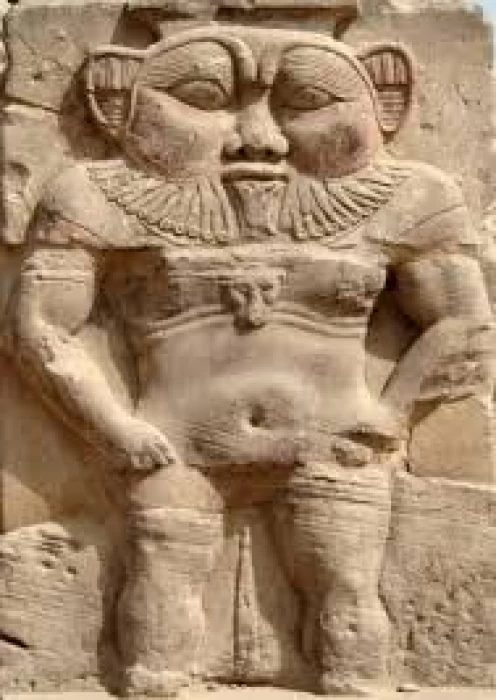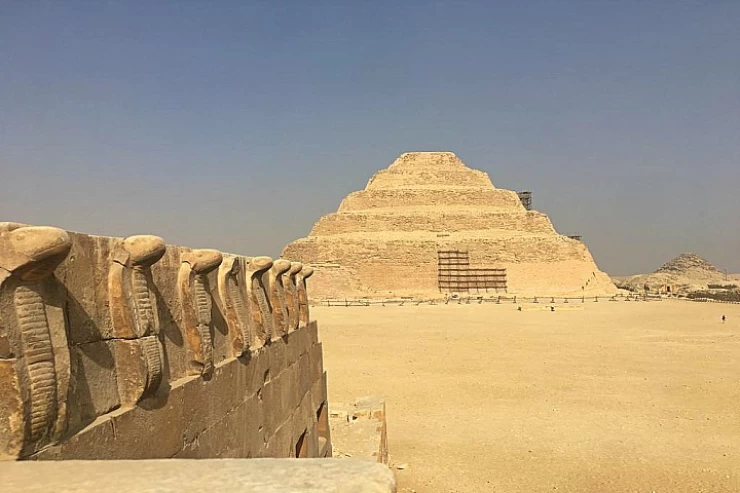
Бог Бес | Бог родов | Древнеегипетский карликовый бог
Бог Бес - единственное божество, представленное исключительно во фронтальной перспективе, он принадлежал к одному из второстепенных божеств Древнего Египта, наиболее восхищавших народное воображение древних египтян.
Бес, божество с демоническими чертами, как ни странно, является семейным божеством. Бес был защитником дома и детей, особенно связанным с критической фазой рождения и защитой от вредных животных. Этот аспект был, вероятно, самым древним. Естественная сфера действия бога Беса распространила его образ на широкий спектр предметов повседневной жизни древних египтян от подголовников, в которых он следил за сном беспомощных спящих, до предметов личной гигиены.
Очень тесными были также связи Беса с танцем и музыкой, с помощью которых он успокаивал разгневанных богинь. Связи с солнечным циклом указывают на него как на популярную форму солнечного бога.
Бес - древнеегипетский сказочный бог, составное существо, одновременно божество и сатанинский воин. Он был богом войны, но также защитником родов и дома, и был связан с желаниями, развлечениями, музыкой и танцами. Хотя первоначально его роль заключалась в охране фараона, он становился все более известным среди простых людей, поскольку по сути защищал женщин и детей. У него не было определенного культа, поэтому в честь него не было создано храмов или жрецов. Однако он был одним из самых знакомых древних египтян и обычно изображался на предметах обихода.
Египет встретит вас своим могучим Нилом вдоль долины Нила, когда вы будете исследовать Луксор на восточном и западном берегу. Большинство посетителей направляются прямо к самой известной достопримечательности - Великой пирамиде Хуфу. Искатели приключений, путешественники и блоггеры могут присоединиться к одному из наших бюджетных туров по Египту, проходящему через пустыню Сахара, например, туры в Сиву из Каира или, предпочтительно, туры в Белую пустыню Египта.
Хотели бы вы совершить путешествие по древней египетской культуре и мифологии? Вы можете сделать это и провести день, посетив Абидос, Гизу, Луксор, Асуан, чтобы увидеть гробницы фараонов, украшенные очень четкими, подробными и красиво нарисованными сценами различных божеств Древнего Египта, а также множество других мест, городов, приключений и занятий в Каире, Вы можете попробовать и забронировать один из наших туров в Египет и Египет туристические пакеты многие частные группы с гидом Каир день туры из аэропорта и Египет день туры для изучения столицы Египта, Каир Вы можете проверить много Египет тур маршруты или пойти на один из наших полных Луксор день туры или Каир день туры, как:
Тур к пирамидам из аэропорта Каира.
Однодневный тур к пирамидам Гизы, в Мемфис и Саккару.
Однодневный тур к пирамидам Гизы и Сфинксу, в Мемфис, Саккару и Дахшур.
Однодневный тур из Каира в Саккару, Мемфис и Дахшур.
God Bes, is the only divinity represented exclusively in frontal perspective, it belonged to one of the minor deities in ancient Egypt most admirable to the popular imagination of the ancient Egyptians.
Bes, a divinity with demonic characteristics, is strangely a family divinity. Bes was a protector of the home and children, particularly linked to the critical phase of birth and the defense against harmful animals. This aspect was probably the most ancient. The natural sphere of action of the god Bes spread his image on a wide range of objects of the daily life of the ancient Egyptians from the headrests, in which he watched over the sleep of the helpless sleepers, to the personal care objects.
Bes's relations with dance and music were also very close, with which he relieved the angry goddesses. Connections with the solar cycle indicate it as a popular form of the solar god.
Bes is an ancient Egyptian fairy god, a composite being, both deity and satanic warrior. He was a god of war, but also a protector of childbirth and the home, and was associated with desire, entertainment, music, and dancing. Although his role originally appears to have been the pharaoh's guard, he increasingly became very famous among common people because he essentially protected women and children. He had no certain cult, so no temples or priests were established in his name. However, he was one of the most familiar of ancient Egyptians and was usually represented on household items.
The god "Bes" reflects an aspect of the ancient Egyptians' interest in fun and humor as a means of entertaining themselves in their daily lives, which were full of hard work and hardship.
The god "Bes" is the ancient Egyptian god of humor and fun. The ancient Egyptians chose for this god, humor, a form that provoked laughter and ridicule, as they formed him as a small dwarf with a full face and muscles, with his tongue sticking out of his mouth, combining the form of a human and a monkey, and his role was to bring joy to the king and the entourage in the royal councils
He only provided protection from danger, while at the same time warding off harm, and was able by his power to prevent evil according to the beliefs of the ancient Egyptians.
In critical circumstances he also appeased nature as told in the famous solar eye legend, when he stopped the wrath of the bloodthirsty goddess Hathor and offered her an alcoholic drink, with a plant-based drug added.
In a more specific field, it brought joy and had a certain regenerative importance that contributed to the achievement and happiness of family life in all aspects of procreation, from masculinity through fertility, to birth and growth. Protecting life and family also includes the healing powers of God only, both in terms of medical healing and magical purification.
The cult of Bes and the rituals surrounding its complex spiritual nature centered on different categories of ritual objects, maintaining certain stereotypical features with stylistic changes over several centuries.
Among these things, so-called vases played a major role. These vases are a class of ceramic vessels decorated with a doll or head, which spread in Egypt from the New Kingdom (16th to 11th centuries BC) to the Hellenistic or Ptolemaic era (330-30 BC) and the periods of the Roman Empire (30 BC). BC – 476 AD), when production peaked.
















